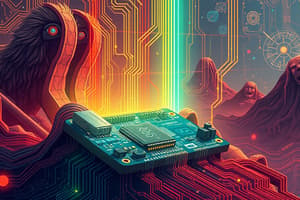Podcast
Questions and Answers
What should you do if you find errors on the website or in the tutorial?
What should you do if you find errors on the website or in the tutorial?
- Leave feedback on the website
- Contact the provided email address (correct)
- Notify the developers via social media
- Ignore it and move on
Which of the following is NOT likely to be included in a tutorial's content?
Which of the following is NOT likely to be included in a tutorial's content?
- Table of Contents
- Detailed code examples
- Copyright & Disclaimer
- Personal anecdotes from the author (correct)
What might be a reason for contacting the tutorial's support?
What might be a reason for contacting the tutorial's support?
- To ask for a refund on a purchased course
- To report incorrect information or errors (correct)
- To request additional tutorials on unrelated topics
- To praise the author for their work
Which section is likely the first component of the tutorial structure?
Which section is likely the first component of the tutorial structure?
What is the purpose of including a Copyright & Disclaimer section?
What is the purpose of including a Copyright & Disclaimer section?
What is the primary purpose of the Arduino platform?
What is the primary purpose of the Arduino platform?
What is required before starting the Arduino tutorial?
What is required before starting the Arduino tutorial?
Which component is used to write and upload code to the Arduino board?
Which component is used to write and upload code to the Arduino board?
What constitutes the 'standard form factor' of Arduino?
What constitutes the 'standard form factor' of Arduino?
Who is the intended audience for the Arduino tutorial?
Who is the intended audience for the Arduino tutorial?
Flashcards are hidden until you start studying
Study Notes
Overview of Arduino
- Arduino is an open-source prototype platform that combines hardware and software for easy access to micro-controller programming.
- It consists of a programmable circuit board (microcontroller) and Arduino IDE, a software for writing and uploading code.
Features of Arduino
- Capable of reading both analog and digital signals from various sensors; effects include motor activation and LED control.
- Programming does not require a separate programmer; code is uploaded via USB cable.
- Arduino IDE employs a simplified version of C++, making it accessible for beginners.
- Standardized form factor facilitates the breakdown of micro-controller functions into understandable components.
Board Types
- Various Arduino boards exist, differing in microcontroller type, number of inputs/outputs, speed, and operating voltage.
- Some boards support 3.7V battery operation, while others require at least 5V for functionality.
Analog Input Pins
- The Arduino UNO has five analog pins (A0 to A5) for receiving signals from analog sensors like humidity or temperature sensors.
Main Microcontroller
- Each Arduino board features a distinct microcontroller, primarily sourced from ATMEL, which acts as the board's central processing unit.
- Microcontroller identification is critical before uploading programs; data sheets provide detailed information.
ICSP Pin
- The ICSP (In-Circuit Serial Programming) pin enables programming of the Arduino via an SPI (Serial Peripheral Interface) setup.
LED Indicators
- A power LED indicates proper board connection when lit.
- TX (transmit) and RX (receive) LEDs signal serial communication activity, with TX flashing at variable speeds based on the baud rate.
Digital I/O Configuration
- Arduino UNO features 14 digital I/O pins; 6 of these support PWM (Pulse Width Modulation) output.
- The power source for the board can be adjusted via a jumper located between the USB and power connectors.
Getting Started with Arduino IDE
- Launch Arduino IDE after downloading and unzipping the application.
- Users can create a new project or open an existing project example, such as the "Blink" example, which toggles an LED on and off.
Selecting Your Board
- To upload a program without errors, ensure the correct board is selected in the IDE under Tools -> Board, matching the board connected to the computer.
Studying That Suits You
Use AI to generate personalized quizzes and flashcards to suit your learning preferences.




